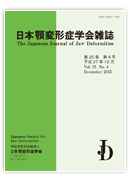巻号一覧

25 巻 (2015)
- 4 号 p. 241-
- 3 号 p. 201-
- 2 号 p. 57-
- 1 号 p. 1-
前身誌
25 巻, 4 号
選択された号の論文の3件中1~3を表示しています
- |<
- <
- 1
- >
- >|
原著
-
重政 理香, 高野 伸夫, 中野 洋子2015 年 25 巻 4 号 p. 241-248
発行日: 2015/12/15
公開日: 2015/12/25
ジャーナル フリーObjective: There have been many previous reports about the relationships between jaw deformity and articulation disorders, but most of such studies were conducted in cases with mandibular prognathism. In contrast, well-defined studies have not been conducted to date in patients with retrognathia although it is considered that such patients have articulation disorders because of the relationship with tegmentum in the anterior tooth area and association with abnormality of the perioral muscles. We previously reported on the effects of orthognathic surgery on vowel sounds in patients with retrognathia. The purpose of this study was to investigate the influence of orthognathic surgery on poor articulation of Japanese consonants in cases with retrognathia.
Materials and Methods: The eight consonant sounds [ka], [ki], [sa], [ɕi], [ta], [tɕi], [pa], [pi] were recorded as speech samples. The investigation was carried out in 11 Japanese female patients with mandibular retrognathia requiring surgery for jaw deformity and malocclusion both at the preoperative and postoperative stages of 3 and 6 months. These subjects were compared with 10 healthy controls. The duration of the consonant sound and the sound pressure level were analyzed.
Results: The duration of the consonant sounds [ka], [ki], [ɕi] and [tɕi] was significantly longer in patients with mandibular retrognathia compared with the controls. The duration of the consonant sounds except [pa] and [pi] after the operation was generally shorter than before the operation. Especially, significant shortening was observed in [ki] in the comparison between before and 6 months after the operation. The sound pressure level for [ki] and [tɕi] was significantly smaller. No significant differences were found in the sound pressure level of the consonant sounds between before and after the operation, but the level was getting larger by 6 months after the operation.
Conclusion: In patients with mandibular retrognathia, the duration of consonants was extended especially in the alveolar fricative sound, velar plosive, and alveolar affricate; furthermore, the sound pressure level was low. However, the articulation disorders tended to be reduced at 6 months after orthognathic surgery by correcting the occlusion and jaw position.抄録全体を表示PDF形式でダウンロード (739K)
症例
-
中山 洋平, 山本 一彦, 堀田 聡, 川上 正良, 上山 善弘, 桐田 忠昭2015 年 25 巻 4 号 p. 249-257
発行日: 2015/12/15
公開日: 2015/12/25
ジャーナル フリーType 1 diabetes mellitus is a disease in which insulin is completely lacking due to the autoimmune destruction of β-cells of pancreatic islets. Since diabetic patients often develop complications after surgery, special consideration is necessary for perioperative management.
We report a patient with jaw deformity complicated with type 1 diabetes mellitus who was successfully treated by two-jaw surgery without complications. The patient was a 16-year-old female with a chief complaint of mandibular protrusion and open bite. She had type 1 diabetes mellitus and had been treated with insulin. After preoperative orthodontic treatment, orthognathic surgery was planned at the age of 19. However, blood sugar level was poorly controlled and unstable. Therefore, she was hospitalized to control her blood sugar level by proper diet and insulin therapy before surgery. Then, two-jaw surgery by Le Fort Ⅰ osteotomy and sagittal split ramus osteotomy was performed. Perioperatively, blood sugar level was strictly controlled in addition to local management.The postoperative course was uneventful, without infection or delay of wound healing. Facial appearance and occlusion were remarkably improved. Three years after surgery, occlusion was stable without relapse tendency.抄録全体を表示PDF形式でダウンロード (804K)
第11回教育研修会
-
―骨切り部位と可能な顎骨移動方向の確認―2015 年 25 巻 4 号 p. 259-271
発行日: 2015/12/15
公開日: 2015/12/25
ジャーナル フリーPDF形式でダウンロード (1524K)
- |<
- <
- 1
- >
- >|